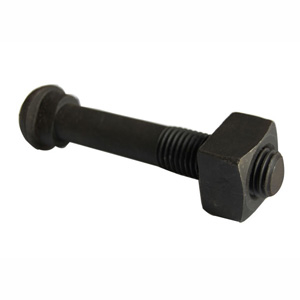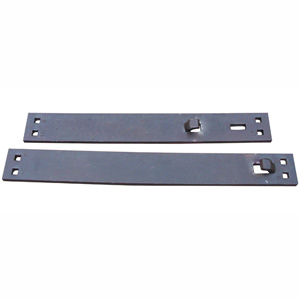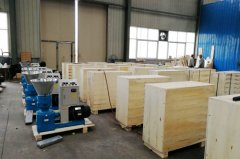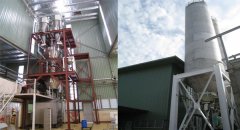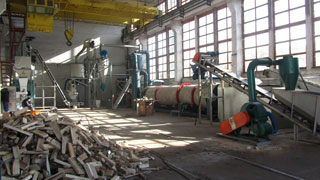Rail joint
Rail joint is a metal bar used to connect the end of 2 steel rails together. It is also called railway fish plate and splice bar. As an important part in railway, it is widely applied in heavy and light rails to ensure the safety of railroad transportation. By adopting rail joints, it can reduce the impact from train wheel and promote the steadiness and continuity of train moving.

Rail joint manufacturer
AGICO is a leading manufacturer and supplier of railway components in China, with decades of production experience. To meet the increasing demand from railroad construction, we have introduced advanced equipments and improved production technology. Up to now, the production of rail joint has reached up to 100MTS per day.
In particular, we can provide one-stop service for various types of rail components including design, manufacture, export and installation. We have been appointed supplier of CRCC, CREC, and CCECC for railway infrastructure projects in 23 countries. Besides, we have built long-term cooperation with global giant like A&K, ATT, InnoTrans and Vossloh.

In terms of steel rails of different standards, the rail joints they adopts are varied. As an experienced rail joints manufacturer, we are capable of providing over 30 types of products according to different standards.
- Rail joints for light rail: 8kg, 9kg, 12kg, 15kg, 18kg, 22kg, 24kg and 30kg
- Rail joints for heavy rail: 38kg, 43kg, 50kg and 60kg
- Rail joints for crane rail: QU70, QU80, QU100 and QU120
Using of railway fish plates
As we know, rail joints are applied to join 2 steel rails together. In practice, they commonly function as bolted joints, compromise joints and insulated joints. Bolted joints are used to join steel rails together before they are welded, while compromise joints serves to join two steel rails with different sections. As for insulated joints, they are used as bonded and non-bonded joints.
Although these 3 types of rail joints plays different roles in railroad, they bears some similar features. They all adopt bolts and bars and form discontinuities on the surface of rail track. And these discontinuities can accelerate track degradation near the rail joints under the pressure of train.
Rail joints of International standards
UIC standard railway fish plate

- C: 0.37~0.44
- Mn: 0.50~0.80
- Si: 0.17~0.37
- S: ≤0.035
- P: ≤0.035
| Standard | Material | Size(kg) | Tensile strength Rm | Yield strength | Elongation A | Reduction of Area Z | Brinell Hardness | Cold Bend d=3a |
|---|---|---|---|---|---|---|---|---|
| UIC864-4& UIC864-8 | Chinese steel grade 40# | U79–UIC54, U85–UIC60 | 550-650Mpa | N/A | ≥18% | N/A | N/A | N/A |
DIN standard railway fish plate

- C: 0.14~0.22, 0.52~0.60
- Mn: 0.30~0.65, 0.50~0.80
- Si: ≤0.30, 0.17~0.37
- S: ≤0.050, ≤0.035
- P: ≤0.045, ≤0.035
| Standard | Material | Size(kg) | Tensile strength Rm | Yield strength | Elongation A | Reduction of Area Z | Brinell Hardness | Cold Bend d=3a |
|---|---|---|---|---|---|---|---|---|
| DIN5902-1995 | Chinese steel grade Q235/Chinese steel grade Q295 | S30 for FL30 rail, S33 for FL33 rail, S41 for FL41 rail, S49 for FL49 rail, FL10, FL14, FL18, FL20, FL41-54 | ≥ 375 Mpa | ≥ 235 Mpa | ≥ 21% | N/A | N/A | N/A |
Chinese standard railway fish plate

- C: 0.52~0.60
- Mn: 0.50~0.80
- Si: 0.17~0.37
- S: ≤0.035
- P: ≤0.035
| Standard | Material | Size(kg) | Tensile strength Rm | Yield strength | Elongation A | Reduction of Area Z | Brinell Hardness | Cold Bend d=3a |
|---|---|---|---|---|---|---|---|---|
| TB/T2345-2008 | Chinese steel grade 55# | 43, 52, 60, 75 | ≥ 785Mpa | ≥ 520Mpa | ≥ 9% | ≥ 20% | HBW 227-388 | 30 degree, no crack |
BS standard railway fish plate

- C: 0.52~0.60
- Mn: 0.50~0.80
- Si: 0.17~0.37
- S: ≤0.035
- P: ≤0.035
| Standard | Material | Size(kg) | Tensile strength Rm | Yield strength | Elongation A | Reduction of Area Z | Brinell Hardness | Cold Bend d=3a |
|---|---|---|---|---|---|---|---|---|
| BS47-1 | Chinese steel grade 40# | BS75R, BS80A, BS90A, BS100A, BS113A | 550-650Mpa | N/A | ≥ 18% | N/A | N/A | N/A |
South American standard railway fish plate

| Standard | Material | Size(kg) | Tensile strength Rm | Yield strength | Elongation A | Reduction of Area Z | Brinell Hardness | Cold Bend d=3a |
|---|---|---|---|---|---|---|---|---|
| According to Customer's requirements | Chinese steel grade 50# or customized | TJ57, TJ ASCE90, TJ UIC60(Brazilian) 75LBS A.S.C.E, 75LBS BSS, 80LBS A.S.C.E, TJ BS80A(Peruvian) | N/A | N/A | N/A | N/A | N/A | N/A |
African standard railway fish plate

| Standard | Material | Size(kg) | Tensile strength Rm | Yield strength | Elongation A | Reduction of Area Z | Brinell Hardness | Cold Bend d=3a |
|---|---|---|---|---|---|---|---|---|
| According to Customer's requirements | Chinese steel grade 50# | 85LB, 85LB-80LB | N/A | N/A | N/A | N/A | N/A | N/A |
AREMA standard railway fish plate

| Standard | Material | Size(kg) | Tensile strength Rm | Yield strength | Elongation A | Reduction of Area Z | Brinell Hardness | Cold Bend d=3a |
|---|---|---|---|---|---|---|---|---|
| AREMA 2007 | Chinese steel grade 50# | 115RE, 119RE, 132RE, 136RE, 141RE... | N/A | N/A | N/A | N/A | N/A | N/A |
Insulated rail joint
Commonly, rail joints are metal bars with conductivity. To build insulated tracks, insulated rail joints is necessary in railroad construction. They are made of thermosetting materials, with the properties of rustproof, anti-erosion, ultraviolet–proof, non-conductive and non-magnetic. With such features, insulated rail joints are unable to be reworked, so they are free from steeling.

2 types of insulated rail joint
Currently, insulated rail joints are widely used in railway construction. Insulated rail joints can be classified into bonded insulated rail joints and polyurethane insulated rail joints. Bonded insulated rail joints are usually used in CWR(continuously welded rails), it can separate circuit in rails and turnouts, and plays the part of transferring longitudinal force arising in the tracks.
The insulated rail joints can be cut into square or angular. The length of bonded rail joints can be up to 60 inches, and specific length is ensured. Most bonded joints are used with A-490 bolts or huck pines(6/8). They are convenient to use in configuration of worn rail and transition rail.
The polyurethane insulated rail joints are specially formulated compound, with micro alloyed parts. They go through UV, ozone, weathering wear and bending stress from heavy traffic. There is polyurethane materials bounded to the rail joints that insulates the steel rails and joints.


